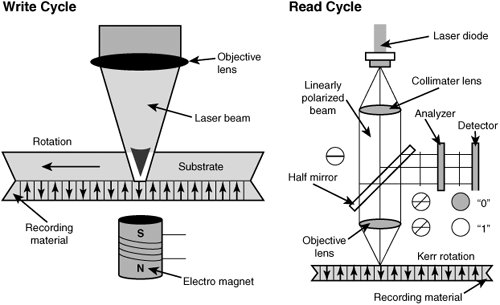Magneto-Optical Drives
| One of the most neglected types of removable-drive technologies is the magneto-optical (MO) drive. Introduced commercially in 1985, magneto-optical drives are now available in capacities exceeding 9GB. Two sizes of magneto-optical media and drives are available for desktop computers: 3 1/2" and 5 1/4". The 3 1/2" drives have capacities up to 2.3GB, and the 5 1/4" drives have capacities up to 9.1GB. 12" MO drives are also available for enterprise systems. Originally, magneto-optical drives were strictly WORM (write once, read many) drives that produced media that could be added to but not erased. WORM drives are still available on the market, but for desktop computer users, read/write MO drives are preferable. Magneto-Optical TechnologyAt normal temperatures, the magnetic surface of an MO disk is very stable, with archival ratings of up to 30 years. One surface of an MO disk faces a variable-power laser, whereas the other surface of the disk faces a magnet. Both the laser beam and the magnet are used to change the data on an MO disk. Figure 10.9 illustrates the magneto-optical writing and reading process. Figure 10.9. Magneto-optical drives use the laser at high power to heat the magnetic surface to enable its contents to be magnetically changed during the write cycle (left) and use the laser at low power to determine the angle of polarization (the Kerr effect) during the read cycle (right). The "optical" portion of an MO drive is the laser beam, which is used at high power during the erasing process to heat the destination area of the MO drive to a temperature of about 200° Celsius (the Curie point, at which a normally magnetic surface ceases to be magnetic). This enables any existing information in that area to be erased by a uniform magnetic field, which doesn't affect the other portions of the disk that are at normal temperature. Next, the laser beam and magnetic field are used together to write information to the location by applying high power to the laser and applying a controlled magnetic signal to the media to change it to either a binary 0 or 1. During the read process, the laser is used at low power to send neutrally polarized light to the surface of the MO disk. The areas of the MO disk that store binary 0s reflect light at a polarization angle different from those that store binary 1s. This difference of one degree is called the Kerr effect. In older MO drives, the erase and write process involved two separate operations, but most recent MO drivesstarting with the Plasmon DW260 of 1997use the LIMDOW method (light intensity modulated direct overwrite) for a single-pass operation with some media types. LIMDOW drives use magnets built in to the disk itself, rather than separate magnets as in older MO drives. LIMDOW drives are fast enough to store MPEG-2 streaming video and make achieving higher capacities easier. MO drives are available from many manufacturers at a variety of price points. Most internal MO drives connect to SCSI interfaces. ATAPI/IDE models are sold by some vendors but aren't as easy to find, and external MO drives are available in SCSI, USB 2.0, and IEEE 1394a interfaces. Comparing MO to "Pure" Magnetic MediaCompared to most high-capacity removable-media drives, MO drive hardware is more expensive (especially in the 5 1/4" media size), but media costs are far less per MB, durability is far better, and performance is as good as or better than the 200MB-or-under class magnetic removable-media drives. The use of SCSI interfaces for most models was a drawback when MS-DOS/Windows 3.1 were the leading operating systems, but Windows 9x/Me/NT/2000/XP have much easier SCSI installation processes, and SCSI interfaces have dropped in price (and are included with some internal drives). IEEE 1394a and Hi-Speed USB (USB 2.0) interfaces available on some models allow the easiest installation process of all for external drives. If you can afford the high initial cost of the 5 1/4" media MO drives, you'll have a fairly fast, durable, long-term storage solution that's also a good storage area for works in progress. |
EAN: 2147483647
Pages: 283